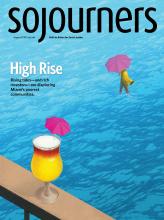PRE-EXPERIENCE: Welcome! You’re alone except for a receptionist, who gently asks you to sign a waiver and gestures to the couch. The sand-colored cushions perfectly complement the soft pink glow of the wall and a pot of shellacked succulents. The coffee is pleasantly warm. The room temperature is perfect. Everything is fine.
You’re here for “Carne y Arena,” a virtual reality experience created by Mexican filmmaker Alejandro G. Iñárritu. The project recreates the experiences of immigrants who cross the Mexico-U.S. border. In 2017, “Carne y Arena” (“Flesh and Sand”) won a Special Award Oscar, the first given for virtual reality. The exhibit accommodates only one visitor at a time, at 15-minute intervals.
You wait on the couch, feeling a twinge of anxiety over an immersive experience that requires isolation and allows no cameras or notebooks. You contemplate the Pinterest-nirvana of the lobby and scratch a few notes while you can.
Entry: So where are we, exactly?
Soon, you’re escorted through the doors of the exhibit, which is housed in an old Baptist church in a gentrifying neighborhood in Washington, D.C. The project will take place across three rooms, a triptych of the migrant experience.
The church was slated for demolition before “Carne y Arena.” On the way in, you pass walls that look strangely familiar—you’ll later realize they are repurposed fence panels from the U.S.-Mexico border, turned horizontal to fit the dimensions of the house of God. You’re pretty sure that works as a metaphor, but before you can chew on it, you’re inside.
Read the Full Article

